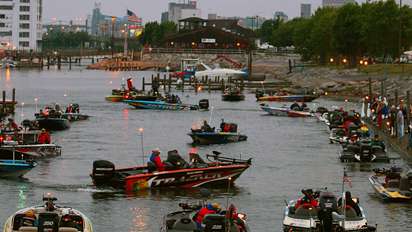
BUFFALO, N.Y. — Sometimes, they'll release one. Other times, it's two or more. And some Elite Pro anglers don't plan on releasing any during the Empire Chase presented by Mahindra Tractors.
"I'm really hoping I don't have to throw mine out," angler Gary Klein said, "but depending on the wind it could be one, two or even three."
No, we're not talking about releasing fish. We are talking driftsocks, also known as drift anchors, para-anchors, or boat brakes. Regardless of what these anglers call them, the higher the wind speeds on Lake Erie during the tournament the higher the likelihood of multiple driftsocks. Brent Chapman from Kansas has used one once before but never two.
"It's just amazing how fast you'll blow across those flats without one," he said.
However, not everyone has plans for using one.
Emerging from a storage bin on Gary Klein's boat, the small nylon driftsock looks like it could be used by a small thrill-seeking woodland creature for a parachute. Rolled up with its ropes wound around it, the simple conical device is thrown overboard, anchored to a cleat.
The extra drag created by the driftsock slows the speed of a boat to a comfortable pace while drifting. And slowing the drift is a crucial component to maintaining an appropriate speed while covering a lot of water. Angler Rick Ash favors the use of drift socks because "they really help you keep your bait down."
Alton Jones took some time to describe how the driftsock plays into his fishing game on a lake like Erie.
"I'd start fishing upwind, with perhaps one off the front and one off the rear of the boat." he said. "Then I'll throw my bait and let the pace of the drift carry the bait high through the water across the strike zones."
Jones liked the fact that this technique offered him the chance to cover a lot of water without much work. "You really don't want to work it in as you're moving downwind, because that means the bait is moving too fast for potential strikes," Jones said.
Boyd Duckett offered a more concise explanation. "The wind blows, you move, and the driftsock slows you down."
The use of driftsocks among the Elite pros differs. Overall, anglers from northern states, especially around the Great Lakes, are more familiar with the devices. Fishermen from around the Gulf of Mexico were equally comfortable as well. Just by fishing the open waters of the Gulf, these anglers had fished with driftsocks in the past.
But for inland Florida anglers such as Steve Daniel and Chris Lane, the chance of seeing driftsocks making an appearance on their boats was slim to none. Daniel had packed one on his boat but claimed he wouldn't need to use it, given his strategy for fishing this tournament. Lane, however, had one very good reason why he didn't even bring a driftsock on board.
"You know, we're fishing for $100,000 and I'm just not interested in trying to learn something new during a tournament," Lane said. "I don't have them and I never use them."
As for Pete Ponds, this week marked the first time he had used a driftsock. "I didn't have much experience using them," he said, "but it worked pretty well in practice, so I'll probably give it a go."
And what does happen to the driftsock when the angler hooks into a bass? Well, for a bass fighting for its life, it's another avenue of escape. A submerged driftsock can become a major factor in landing a fish if an angler doesn't have time to remove it, or a fish decides to tangle himself within the driftsock's ropes.
"It's just an extra obstacle," Marty Stone said. "You've really got to pay attention out there."
With windmills already churning not far from Day One's launch-site, anglers will need to slow things down and pay attention to everything out there on the waters of this Great Lake, and now that includes driftsocks.
